MASS inter-comparison at Cerro Tololo
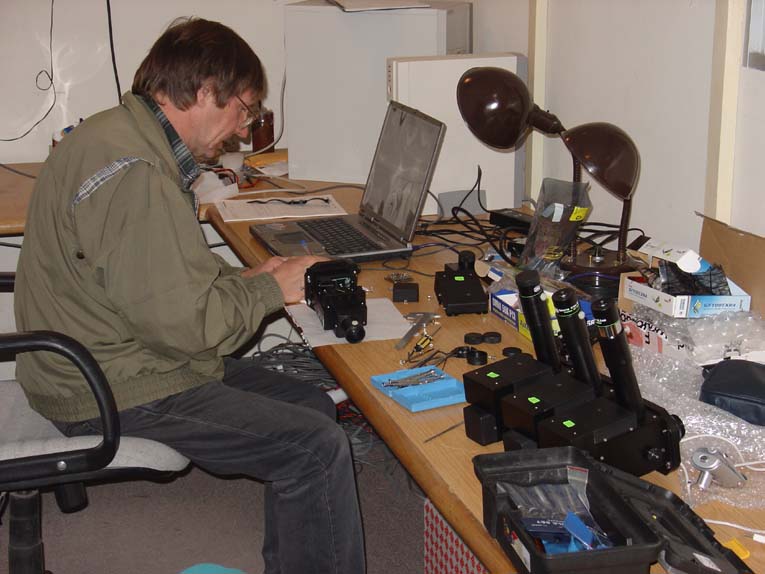 ESO has procured 4 new MASS-DIMM instruments for the need of the
site-testing for future Extremely Large Telescopes. The electronics
and software for these ELT-DS units were developed in Moscow by the
team led by Victor Kornilov. The mechanics has been fabricated by the CTIO
workshop in Chile. The picture shows assembly and testing of these 4 new units
done by V. Kornilov.
ESO has procured 4 new MASS-DIMM instruments for the need of the
site-testing for future Extremely Large Telescopes. The electronics
and software for these ELT-DS units were developed in Moscow by the
team led by Victor Kornilov. The mechanics has been fabricated by the CTIO
workshop in Chile. The picture shows assembly and testing of these 4 new units
done by V. Kornilov.
Upon assembling the new MASS-DIMM instruments, we [Marc Sarazin (ESO),
Victor Kornilov (SAI) and Andrei Tokovinin (CTIO)] tested them at Cerro
Tololo and compared with other MASS-DIMM instruments. This has been
done on March 10-12, 2006. We enjoyed excellent sky conditions and
good seeing.
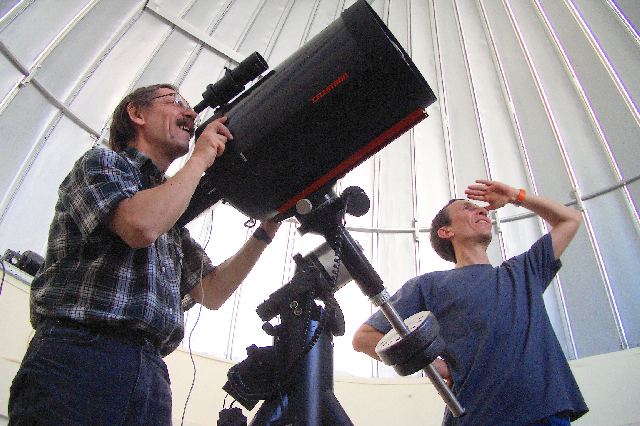 ELT-DS MASS-DIMMs
worked with the Celestron C11 telescope
on the equatorial Losmandy mount installed inside the USNO dome.
The picture shows Victor and Marc in the dome.
ELT-DS MASS-DIMMs
worked with the Celestron C11 telescope
on the equatorial Losmandy mount installed inside the USNO dome.
The picture shows Victor and Marc in the dome.
Tololo MASS-DIMM
worked in the 6m tower with the Meade LX-200 25-cm telescope, in
robotic mode. This is the instrument providing the regular site data
for Tololo (see daily plots at
here
).
A similar monitor works at Cerro Pachon.
New MASS-DIMM instrument (MD20) was also
operated during this period with a Meade RCX400 30cm telescope. The
rationale for using this telescope is its improved focus control.
[
more on this telescope... ].
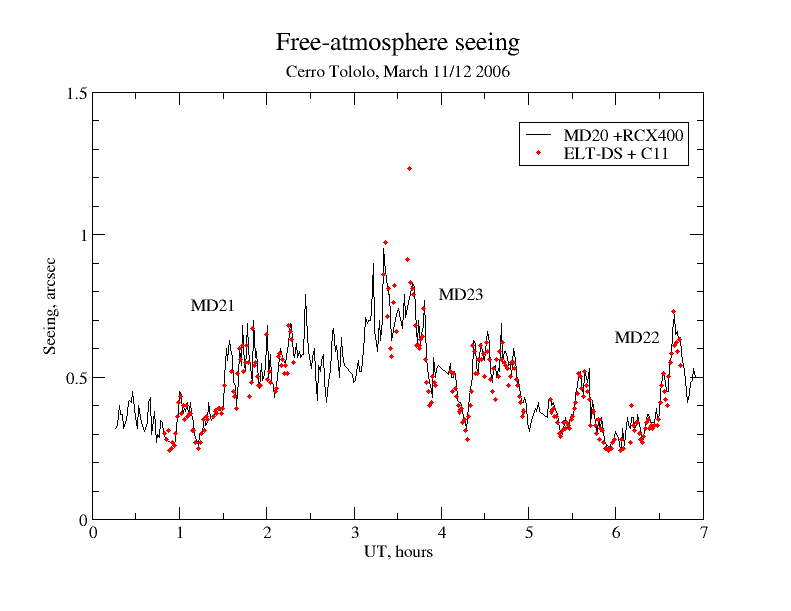 Comparison of free-atmosphere seeing
shows a very good agreement between the MASS instruments. During the
night of March 11/12, three new MD units (MD21, MD23, MD22) were
changed on the Celestron, while the MD20 unit worked continously with
RCX400. The free-atmosphere seeing (turbulence above 0.5km) is
estimated directly from the scintillation indices.
Comparison of free-atmosphere seeing
shows a very good agreement between the MASS instruments. During the
night of March 11/12, three new MD units (MD21, MD23, MD22) were
changed on the Celestron, while the MD20 unit worked continously with
RCX400. The free-atmosphere seeing (turbulence above 0.5km) is
estimated directly from the scintillation indices.
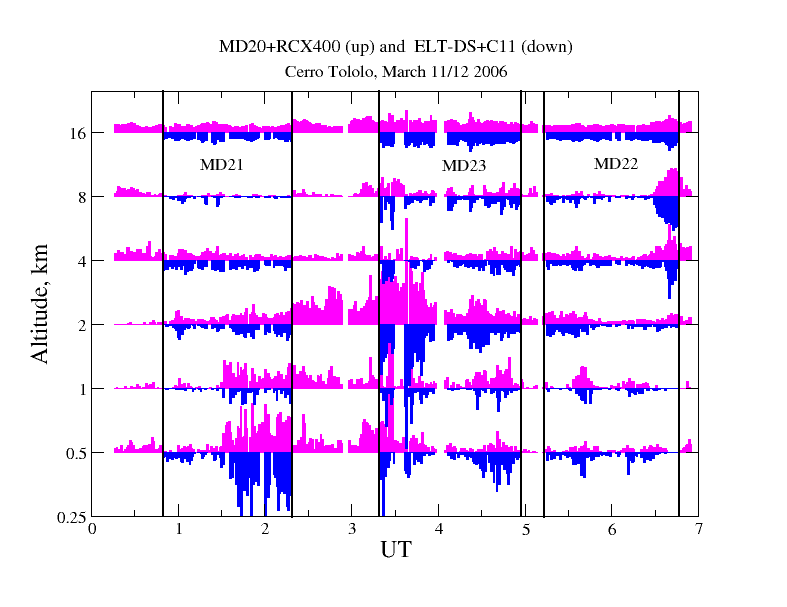 Turbulence profiles are
measured simultaneously on the same night of March 11/12. The upper
halves of the bars (pink) depict the turbulence intensity measured by the
MD20, and the lower halves (blue) - by the three ELT-DS units.
Turbulence profiles are
measured simultaneously on the same night of March 11/12. The upper
halves of the bars (pink) depict the turbulence intensity measured by the
MD20, and the lower halves (blue) - by the three ELT-DS units.
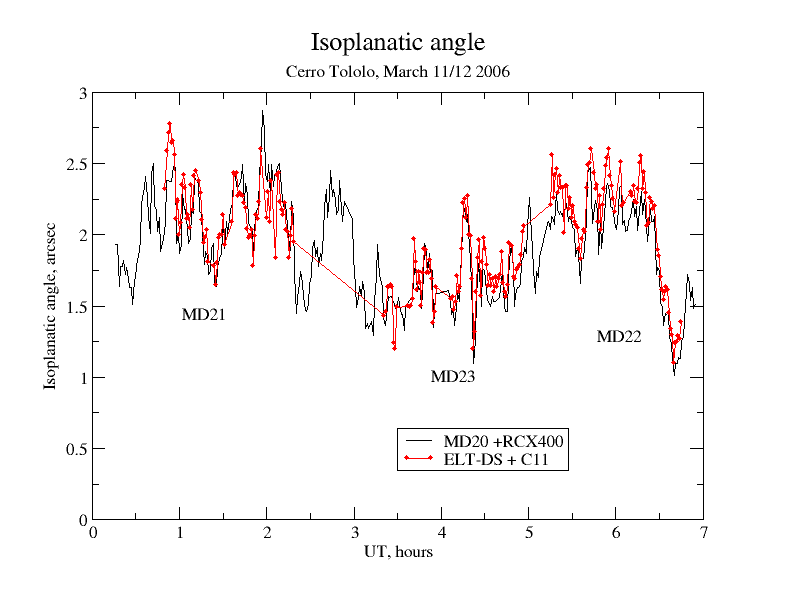 Isoplanatic angle
measured by two MASS units is in good mutual agreement.
The isoplanatic angle, like seeing, is estimated directly from the
scintillation indices.
Isoplanatic angle
measured by two MASS units is in good mutual agreement.
The isoplanatic angle, like seeing, is estimated directly from the
scintillation indices.
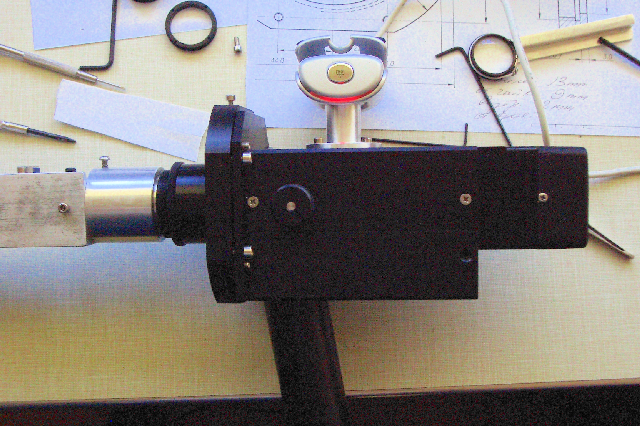 The DIMM channel can use
different CCD detectors. In the left picture, a cheap web camera is
attached to the MASS-DIMM and the assembly is tested with a star
simulator.
The webcam DIMM is described by
C. Cavadore
The DIMM channel can use
different CCD detectors. In the left picture, a cheap web camera is
attached to the MASS-DIMM and the assembly is tested with a star
simulator.
The webcam DIMM is described by
C. Cavadore
 The next image shows defocused spots from the star simulator captured
with the ST-2000-XN camera. These images are taken to verify the good
optical quality of the DIMM channel - the lack of aberrations like
astigmatism and the equality of the focus of two spots.
The next image shows defocused spots from the star simulator captured
with the ST-2000-XN camera. These images are taken to verify the good
optical quality of the DIMM channel - the lack of aberrations like
astigmatism and the equality of the focus of two spots.
[ Back to MASS homepage ]
 ESO has procured 4 new MASS-DIMM instruments for the need of the
site-testing for future Extremely Large Telescopes. The electronics
and software for these ELT-DS units were developed in Moscow by the
team led by Victor Kornilov. The mechanics has been fabricated by the CTIO
workshop in Chile. The picture shows assembly and testing of these 4 new units
done by V. Kornilov.
ESO has procured 4 new MASS-DIMM instruments for the need of the
site-testing for future Extremely Large Telescopes. The electronics
and software for these ELT-DS units were developed in Moscow by the
team led by Victor Kornilov. The mechanics has been fabricated by the CTIO
workshop in Chile. The picture shows assembly and testing of these 4 new units
done by V. Kornilov.
 ELT-DS MASS-DIMMs
worked with the Celestron C11 telescope
on the equatorial Losmandy mount installed inside the USNO dome.
The picture shows Victor and Marc in the dome.
ELT-DS MASS-DIMMs
worked with the Celestron C11 telescope
on the equatorial Losmandy mount installed inside the USNO dome.
The picture shows Victor and Marc in the dome.
 Comparison of free-atmosphere seeing
shows a very good agreement between the MASS instruments. During the
night of March 11/12, three new MD units (MD21, MD23, MD22) were
changed on the Celestron, while the MD20 unit worked continously with
RCX400. The free-atmosphere seeing (turbulence above 0.5km) is
estimated directly from the scintillation indices.
Comparison of free-atmosphere seeing
shows a very good agreement between the MASS instruments. During the
night of March 11/12, three new MD units (MD21, MD23, MD22) were
changed on the Celestron, while the MD20 unit worked continously with
RCX400. The free-atmosphere seeing (turbulence above 0.5km) is
estimated directly from the scintillation indices.
 Turbulence profiles are
measured simultaneously on the same night of March 11/12. The upper
halves of the bars (pink) depict the turbulence intensity measured by the
MD20, and the lower halves (blue) - by the three ELT-DS units.
Turbulence profiles are
measured simultaneously on the same night of March 11/12. The upper
halves of the bars (pink) depict the turbulence intensity measured by the
MD20, and the lower halves (blue) - by the three ELT-DS units.
 Isoplanatic angle
measured by two MASS units is in good mutual agreement.
The isoplanatic angle, like seeing, is estimated directly from the
scintillation indices.
Isoplanatic angle
measured by two MASS units is in good mutual agreement.
The isoplanatic angle, like seeing, is estimated directly from the
scintillation indices.
 The DIMM channel can use
different CCD detectors. In the left picture, a cheap web camera is
attached to the MASS-DIMM and the assembly is tested with a star
simulator.
The webcam DIMM is described by
The DIMM channel can use
different CCD detectors. In the left picture, a cheap web camera is
attached to the MASS-DIMM and the assembly is tested with a star
simulator.
The webcam DIMM is described by
 The next image shows defocused spots from the star simulator captured
with the ST-2000-XN camera. These images are taken to verify the good
optical quality of the DIMM channel - the lack of aberrations like
astigmatism and the equality of the focus of two spots.
The next image shows defocused spots from the star simulator captured
with the ST-2000-XN camera. These images are taken to verify the good
optical quality of the DIMM channel - the lack of aberrations like
astigmatism and the equality of the focus of two spots.